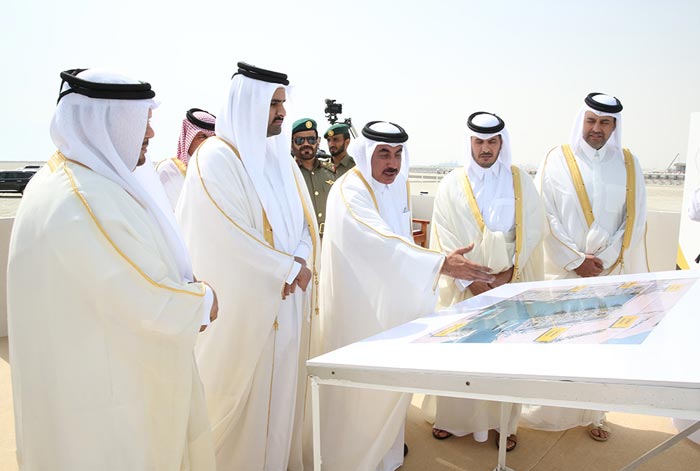HH the Deputy Emir Sheikh Abdullah bin Hamad al-Thani is briefed by HE the Transport Minister Jassim Seif Ahmed al-Sulaiti about the new port as HE the Prime Minister and Interior Minister Sheikh Abdullah bin Nasser bin Khalifa al-Thani and other dignitaries look on.
By Ayman Adly
Staff Reporter
HH the Deputy Emir Sheikh Abdullah bin Hamad al-Thani unveiled the name of the new port at Umm Al-Houl in the Mesaieed area at a ceremony on Thursday.
Hamad Port will become fully operational in 2016.
During the ceremony, the new port’s basin was flooded.
HE the Prime Minister and Interior Minister Sheikh Abdullah bin Nasser bin Khalifa al-Thani, HE the Transport Minister Jassim Seif Ahmed al-Sulaiti, a number of other ministers, top government officials, and diplomats attended the ceremony.
“The wise leadership and comprehensive vision of HH the Emir Sheikh Tamim bin Hamad al-Thani and the close follow-up of HE the Prime Minister are the main reason for delivering this phase of such a huge project ahead of schedule,” al-Sulaiti said.
The minister said Hamad Port will be partially opened for operations by the end of this year, including the general cargo loading and discharging terminal, and terminals for importing vehicles and building equipment.
The full operation of the first phase of the port project is slated for the end of 2016. In between, the container handling capacity at the existing Doha Port will be increased.
"Qatar is implementing an ambitious programme that includes major projects of transport infrastructure, such as the development of land, sea, air, marine and rail networks," he said.
Qatar has allocated more than $140bn to develop infrastructure and transport projects in the next five years within the programme to achieve Qatar National Vision 2030.
“When completed, this port will increase the volume of Qatar exports and imports, and the maritime trade between Qatar and the rest of the world. It is a new door to boost development, diversify the sources of income of the Qatari economy and improve its competitive potential in the region, transforming the country into a commercial centre."
The minister stressed close co-ordination has been maintained with the Ministry of Environment throughout the different stages of the project to preserve a clean and sustainable environment.
The port basin is 4km long, 700m wide and 17m deep and once fully completed, it will increase the throughput capacity to over of 6mn containers per year and provide transshipment links by rail, sea or road to the other GCC and Arab countries.
Hamad Port will be equipped with 12 ship-to-shore cranes, each capable of lifting 80 tonnes or two 40ft containers at a time. Rubber tyred gantry cranes will handle single containers and mobile cranes and forklifts, tug boats, pilot boats and mooring boats will ensure flow within the port.
The port facilities will include a multi-use terminal for general cargo, grain facility, vehicle terminal, livestock terminal, facility for the Qatar Coast Guard, and offshore supply base. The port will have advanced safety and security systems, a dedicated customs inspection area to expedite the clearance of goods, a port control tower and a ship inspection platform. The port also includes marine facilities for a fishing harbour, and facilities like warehouses, mosques, rest areas and a cafeteria, besides government offices and port administration centres.
The establishment of an economic zone adjacent to the new port will facilitate manufacturing industries and position the nation to increase its non-oil and gas exports.
The creation of an integrated logistics park within the port area will provide connection to the Qatar and GCC Rail Freight network.
Along with the new expressway interchanges, Hamad Port will facilitate cost-effective cargo handling and will position Qatar as the new regional shipping hub.
Engineering and construction works on the project, which started in June 2010, covers 26sq km. Over 60mn man hours have been done and the project employs a workforce of 9,000, reaching 17,000 during the peak of construction this year and two of the world’s largest cutter suction dredges.
There are 35,224 blocks in the quay wall ranging from 60 tonnes to 140 tonnes in weight, a total of 1.4mn cu m of concrete was used for production of the blocks. A total of 6,900 tonnes of explosives were used in the excavation of the port basin. Safety was a high priority on the project, achieving 20mn man-hours to date without a Lost Time Injury.



